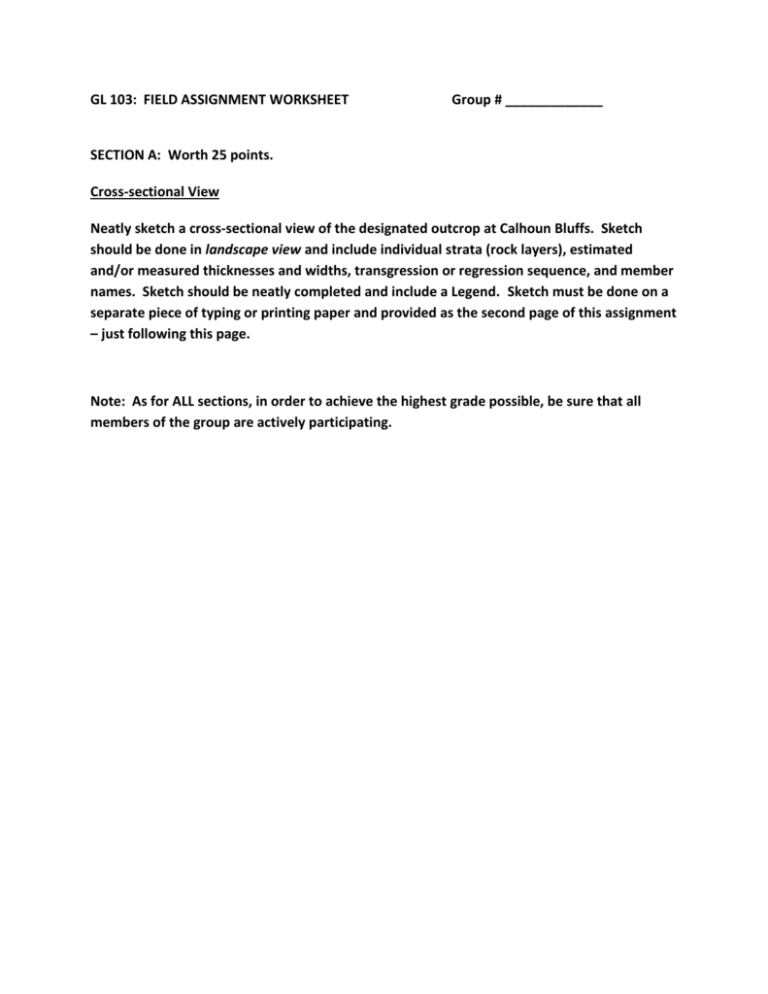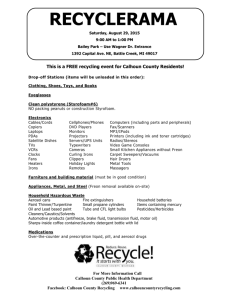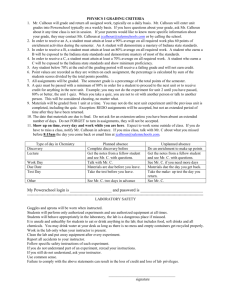
GL 103: FIELD ASSIGNMENT WORKSHEET
Group # _____________
SECTION A: Worth 25 points.
Cross-sectional View
Neatly sketch a cross-sectional view of the designated outcrop at Calhoun Bluffs. Sketch
should be done in landscape view and include individual strata (rock layers), estimated
and/or measured thicknesses and widths, transgression or regression sequence, and member
names. Sketch should be neatly completed and include a Legend. Sketch must be done on a
separate piece of typing or printing paper and provided as the second page of this assignment
– just following this page.
Note: As for ALL sections, in order to achieve the highest grade possible, be sure that all
members of the group are actively participating.
SECTION B: Worth 25 points.
Outcrop Descriptions
Directions: Describe the three the lower-most rock units (strata) present at the Calhoun
Bluffs field site. Examples for describing the three rock units include: name of rock unit,
color of rock, any obvious mineral compositions and/or fossils, erosional features (cutting in
or protruding out), and thicknesses of rock units. Be sure to write descriptions with complete
sentences and in paragraph form. Be sure to spell correctly. This section must be typed
single-spaced in the section below and be in your own words – not copied from an internet
source. Each description is worth 8 points. One point is given for the effort.
Lower Rock Unit: Base of the outcrop.
Second Rock Unit: Just above the base of the outcrop.
Third Rock Unit: Just above the second outcrop.
SECTION C: Worth 25 points. Worth 1 point each.
Calhoun Bluffs Interpretation
Answer the following questions pertaining to the Calhoun Bluffs region:
1.
From your observations what member name has the most fossils?
____________________________________
2.
What Period of time is represented by the rocks at Calhoun Bluffs?
____________________________________
3.
What major types of rocks (sedimentary, igneous, metamorphic, or all three) are
found at Calhoun Bluffs?
____________________________________
4.
What evidence at the Calhoun Bluffs indicates that the region was once briefly
inundated with swampy waters?
____________________________________
5.
What formation name is assigned to ALL rock members of the Calhoun Bluffs region?
____________________________________
6.
What is the oldest layer (member) exposed at the Calhoun Bluffs?
_____________________________________________________________
7.
What is the youngest layer (member) exposed at the Calhoun Bluffs?
_____________________________________________________________
8.
Does the Curzon Limestone member represent deep or shallow marine waters?
____________________________________
9.
What type of sedimentary rock at the Calhoun Bluffs is evidence of a coastal (beach)
deposition?
______________________________________
10.
Are the fossils found at Calhoun Bluffs representing the remains of invertebrate or
vertebrate ancient life forms?
______________________________________
11.
Based on fossil preservation, what types (body, trace, and/or chemical) are
represented for the fossils preserved at Calhoun Bluffs?
______________________________________
12.
What type of major depositional environment is represented by all of the rock
members at the Calhoun Bluffs? (Examples: river floodplain, swamp, shallow marine,
desert, delta, tributary channels, marsh, etc.)
______________________________________
13.
How many millions of years ago, do the rocks at Calhoun Bluffs represent?
______________________________________
14.
Are there any glacial boulders observed at the designated outcrop?
___________ If so, where? ______________________________________________
Using the Stratigraphic Classification of Upper Pennsylvanian rocks in Kansas (Zeller, 1968)
handout, answer the following questions:
15.
Is the Calhoun Bluffs region younger or older than the rock members of the Oread
Limestone Formation?
______________________
16.
What group is represented at the Calhoun Bluffs region? ______________________
17.
What stage is represented at the Calhoun Bluffs region? ________________________
18.
If you were in Physical Geology before taking this class, you will remember the rock
member name Rulo Limestone. It was located near the Hollywood Theatres in
Topeka, KS. If you have not taken this class, you can still answer the question. What
formation name does this rock member (Rulo LS) belong to?
__________________________
19.
Of the three major sedimentary rocks found in Kansas (limestone, sandstone, and
shale), which two occur the most in the Upper Pennsylvanian stratigraphic chart?
___________________________
20.
______________________________
What Era of time is represented for the Calhoun Bluffs? (Precambrian, Paleozoic,
Mesozoic, or Cenozoic).
_________________________________
21.
Glacial boulders are located in and around the NE region of Kansas. Based on their
composition and rock type, what name has been given to these boulder-sized rocks?
_________________________________
22.
Is there any evidence of plant material at the Calhoun Bluffs region? And, if so, what
formation name are they found in?
_________ (yes or no) Formation: __________________
23.
Would it be possible to find crinoids stems at the Calhoun Bluffs region?
____________
24.
If yes, why? ______________________________________
Are the rock units in Lawrence, KS younger or older than the Calhoun Bluffs?
________________________
25.
How many rock members make up the Echo Cliff Region near Dover, KS? (3, 6, 8?)
________________
SECTION D: Worth 25 points.
Field Trip Experience
Write a reflection of your field trip experience with a minimum of 150 words, typed with
double-spacing (not multiple). Be sure to spell and grammar-check. Avoid typos and run-on
sentences. Use your own words and get feedback from all members of your group.
Some things you might want to write about include:
1.
What did you discover and learn on the field trip?
2.
How did this field trip contribute to what you learned in the classroom?
3.
What did you enjoy most about this field trip?
Stratigraphic Classification of Upper
Pennsylvanian rocks in Kansas (Adapted
from Zeller, 1968.
Copyright 2014: Geology for Today -- geology4today.com. All rights reserved.








